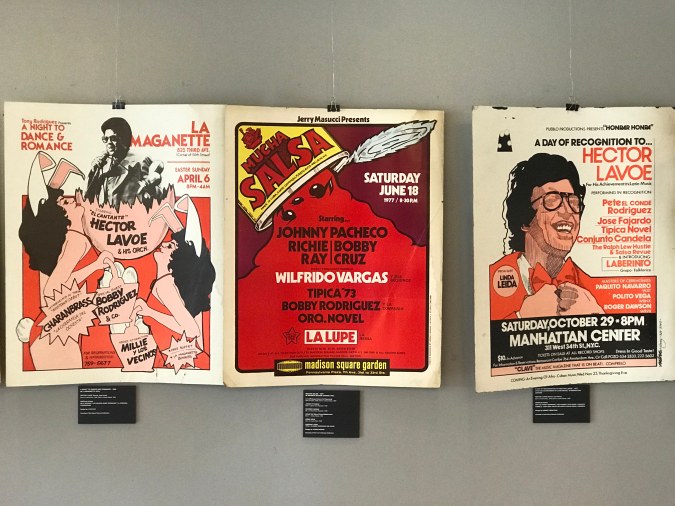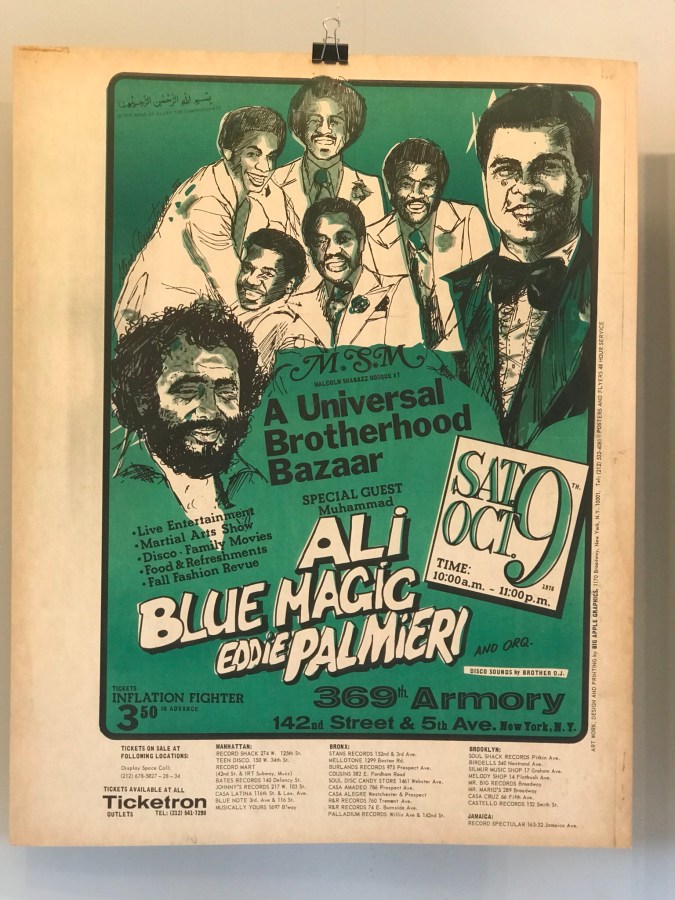“I couldn’t believe someone was so interested in something I love,” recalls Henry Herrera at the opening for Sabor y Ritmo Antillano: N.Y.C. Latin Music Concert Posters of the 1970s & 1980s. A librarian from Queens named Jhensen Ortiz had contacted him through Ebay, curious about the vintage Latin music posters he had for sale. Herrera says they were a gift from none other than Mike Amadeo, long-time owner of Casa Amadeo, the iconic Latin music shop in the Bronx.
Weeks later, Herrera and his family traveled from Connecticut to Harlem for the opening reception of an exhibition featuring about half of his private collection. “I’m so humbled by this whole thing, I just don’t have any words to express it,” he says.
Now covering the four walls of the Rio II Gallery, Sabor y Ritmo Antillano is an unassuming panorama of the Latin music scene in New York City from both a “community and commercial perspective,” as the exhibition description reads. It is also a visual archive, designed to colorfully capture the viewer’s attention, in English or Spanish, long enough to justify an endless stream of text – everything from dates to addresses, record shops to radio stations, promoters to playful taglines, and, in the particular case of one enterprising illustrator, a phone number (still listed to that same individual).

“You can see the energy and the potency of what was happening in terms of these musical events in the Latino community,” adds retired history professor Anthony Stevens-Acevedo, a former colleague of Jhensen Ortiz at the CUNY Dominican Studies Institute.

There are also the names, many belonging to Latin music legends and rising stars such as La Lupe, Wilfrido Vargas, the Palmieri brothers, Tito Puente, Milly Quezada, Héctor Lavoe, and Ismael Rivera; as well as the names of venues like the Cerromar Casino, The Hunts Point Palace, The Roxy.
Also noteworthy, according to Latin music historian Richie Blondet, is the inclusion of ephemera from the golden eras of salsa and merengue in New York City, in the same exhibition. Generally speaking, Sabor y Ritmo Antillano is true to the representation implied by its title, with the best talent from Cuba, the Dominican Republic, and Puerto Rico showcased alongside one another, in some cases, on the same night.
The project began with Ortiz stumbling upon Herrera’s posters not long after beginning an impromptu search for Latin music memorabilia. Ortiz then conducted some research before enlisting co-curator Wilton Salazar, a college classmate at the City College of New York with a background in fine arts. With a shared interest in Latin music, the pair set about identifying which posters would best convey the unique era to which the collection belonged. For Salazar, several techniques, such as hand-drawn illustration, collage, and color separation, give personality to the work of local Latinx illustrators and graphic designers. Salazar also noted the abrupt shift caused by the advent of the personal computer in the mid-1980s, adding immediacy to methods that would soon lessen in demand.


Notwithstanding his work with the CUNY Dominican Studies Institute, where, among other things, he curates a vinyl collection of recordings by Dominicans in New York City, Sabor y Ritmo Antillano is an unprecedented undertaking for Ortiz. “I’ve never done anything like this before, I’m sort of stepping out on my own to bring this to the public.”
He did, however, envision an exhibition that would be accessible to the community, which is why a community-oriented venue was chosen, along with a modest conceptualization geared toward firsthand accounts. “I come from an academic background, but I wanted the community to inform me about the history,” Ortiz says.“I’m really excited for the conversation of what all this means for the present.” In short, Sabor y Ritmo Antillano is one of too few opportunities for the New York Latinx community to be seen and heard, which makes it all the more invaluable. Or as Herrera explained, “The people who got to see this [music], they gotta hold onto it forever.”
Sabor y Ritmo Anitllano runs until the end of August.





